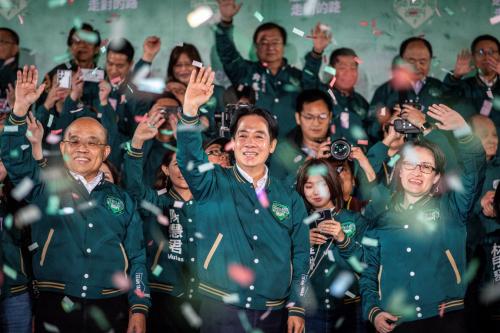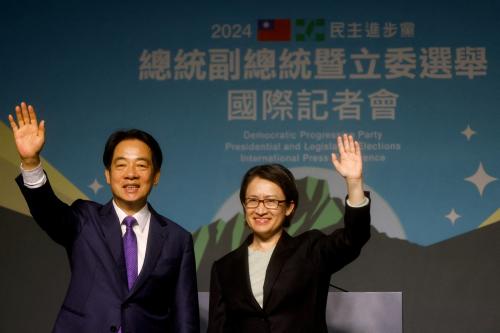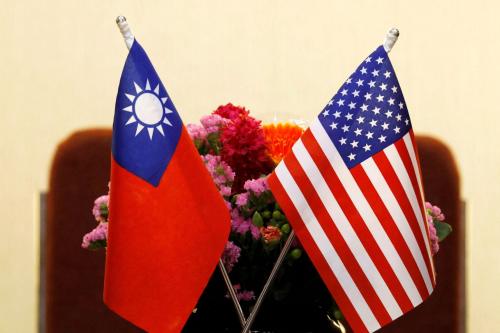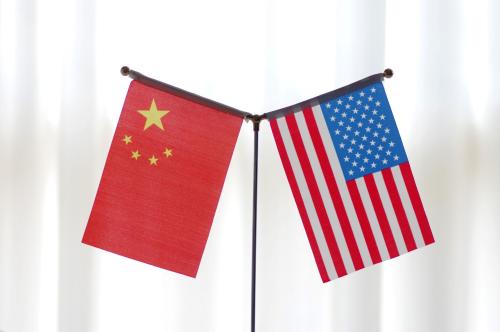This piece is part of the Taiwan-U.S. Quarterly Analysis series, which features the original writings of experts with the goal of providing a range of perspectives on developments relating to Taiwan.
Following the inauguration of William Lai in May 2024, Beijing engaged in displays of military prowess around Taiwan and suspended preferential tariff treatments under the Economic Cooperation Framework Agreement (ECFA). These actions, viewed as responses to the Democratic Progressive Party’s (DPP) prolonged hold on the presidency, were also aimed at unsettling market confidence in the DPP’s leadership by raising cross-Strait tensions.
However, Taiwan’s stock index not only remained resilient but surged by a notable 3% in the two weeks following Lai’s inauguration, reaching a historic high on June 6, 2024, at 21,902. This upsurge marked a continuous bullish trend from the index’s low point during the COVID-19 outbreak (March 2020), growing by an impressive 140% to its current peak. In stark contrast, Hong Kong’s Hang Seng Index plummeted about 19% and the Shanghai Composite increased 11% over the same timeframe, highlighting Taiwan’s standout economic performance.
The bull market mirrored a flourishing economy, propelled by increased investments and exports in Taiwan, which outperformed regional peers like Singapore, South Korea, and Hong Kong, boasting an average growth rate of 3.4% from 2020 to 2023.
This economic renaissance has steered Taiwan toward enhanced prominence in the global information and communication technology (ICT) supply chain amid the ongoing artificial intelligence (AI) revolution. Renowned tech figures such as Nvidia’s CEO, Jensen Huang, have lauded Taiwan as the electronic industry’s epicenter, recognizing its pivotal role during events in Computex 2024 in Taipei. Huang’s sentiments resonated with leaders from other tech giants, exemplifying that industry remains optimistic despite China’s disruptive military and economic tactics.
Over the past decade, Taiwan’s economy transformed by pivoting toward advanced ICT sectors, catalyzed in part by Xi Jinping’s nationalistic aggression. Here are three observations about this development:
International isolation imposed by China has hastened the diminishing of traditional industries in Taiwan.
As the international trade landscape gradually shifted from globalism to economic regionalism in the 21st century, smaller trading nations have actively pursued bilateral and multilateral free trade agreements (FTAs) with their trade partners. Within the context of the Asia-Pacific’s regional development, China’s increasing economic influence has discouraged Taiwan’s trade partners from signing FTAs with Taipei. Consequently, Taiwanese manufacturing companies in traditional sectors were compelled to diversify their operations outside Taiwan. This trend led to the concentration of the remaining manufacturing enterprises in Taiwan within the ICT sector, which have benefitted from tariff-free arrangements under the World Trade Organization’s Information Technology Agreement. By the time the Chinese-led Regional Comprehensive Economic Partnership (RCEP) was signed in November 2020, approximately 75% of Taiwan’s exports to RCEP countries were ICT-centric. Taiwanese businesses adapted to mitigate the impact of China’s imposed isolation effectively.
Despite these adaptations, China’s mercantilist policies and state subsidies directed toward mass-production industries resulted in intense price competition for traditional manufacturing sectors like textiles, electrical equipment, petrochemicals, and steel around the world. This competitive pressure also led to the decline of numerous traditional manufacturing companies in Taiwan, contrasting with the rapid growth of ICT firms. A notable illustration of this shift is reflected in the evolution of Taiwan’s top corporations—in 2000, only three of the 10 largest companies were in the ICT domain and six were in traditional industries, whereas by 2024, seven of the top 10 belonged to the ICT industry, with the remaining three in financial services.
South Korea, a country that has signed FTAs with many countries around the world, provides a useful point of comparison. Much like Taiwan, South Korea is highly dependent on exports, but it has been able to maintain a balanced composition of its manufacturing exports in sectors other than ICT. However, China’s price competition made this balanced composition a curse in disguise. Since the mid-2010s, South Korea’s exports have constantly performed worse than Taiwan’s, although Taipei’s new Taiwan dollar was also stronger than the South Korean won during that time. As a result, Taiwan’s GDP per capita surpassed South Korea’s in 2022 for the first time in 18 years. Taiwan’s stock market capitalization also surpassed South Korea’s at the same time.
International isolation forced trade-dependent Taiwan to concentrate its exports on tariff-free ICT industries. In turn, this saved Taiwan from China’s distorted price competition for manufacturing exports in traditional industries. When Beijing announced the suspension of 134 items for ECFA tariff reductions in late May, for example, all of them were in traditional industries. Taiwan’s Ministry of Economic Affairs estimated that the suspension will affect only 2% of Taiwan’s total exports.
Repatriating capital from China helped build a greener and better ICT supply chain in Taiwan.
Between 1990 and 2010, Taiwan was the largest foreign investor in Chinese manufacturing, which helped China quickly integrate into the global supply chain and become the largest trading power in the world through export-oriented industrialization. Once China established itself as the global manufacturing powerhouse, the Chinese government launched a series of import substitution policies to build a more self-sufficient domestic “red supply chain.” Therefore, foreign investors no longer enjoyed the preferential treatment they used to have, and they gradually encountered fierce competition from heavily-subsidized local companies. Taiwanese companies didn’t grasp the policy change and continued investing heavily, with foreign direct investment (FDI) to China comprising a significant portion of Taiwan’s total FDI, peaking at 84% in 2010.
Competition from the red supply chain, initiated during Hu Jintao’s era in China, did not trigger significant capital outflows initially. It wasn’t until Xi Jinping’s tenure, which was marked by a prioritization of national security over economic progress, coupled with events like the suspension of Ant Group’s initial public offering, the crackdown on the Hong Kong Anti-extradition movement, and the passage of Counter-Espionage Law, that FDI to China began to dwindle. Subsequently, from 2018 to 2022, FDI to China dipped below that to ASEAN for the first time, hitting a three-decade low in 2023. Taiwan mirrored this trend as its FDI share in China plummeted from 84% in 2011 to 11% in 2023.
Responding swiftly, the Taiwanese government introduced a series of repatriation policies in July 2019, encouraging Taiwanese companies to reinvest in Taiwan, particularly in green, high-value-added industries pivotal to the global supply chain. By June 2024, these policies had attracted over $71 billion back to Taiwan, predominantly in the ICT sector.
The U.S.-China tech conflicts further reinforced Taiwan’s centrality in the AI revolution.
In 2015, China introduced “Made in China 2025” to propel the red supply chain into a dominant force in global high-tech manufacturing, earmarking crucial sectors such as AI, 5G, aerospace, semiconductors, electric vehicles, and biotech. Semiconductors, vital for AI and 5G, emerged as a key focus. China heavily invested in semiconductor development to bolster the red supply chain. Yet disruptions to the global supply chain during the COVID-19 pandemic underscored Taiwan’s critical role in it, as Taiwan supplied 60 percent of global semiconductors and more than 90 percent of the advanced ones.
Xi’s ambitious plans for China’s semiconductor manufacturing and coercively annexing Taiwan raised international alarms over the geopolitical risks to the semiconductor supply chain’s resilience. In fact, President Donald Trump’s trade war with China evolved into a technological war in 2019 when the U.S. government started to restrict Chinese companies from obtaining the chips and equipment they needed to power their semiconductors and 5G networks, especially those involved in “dual use” applications that skirt the line between military and civilian technologies. President Joe Biden further extended the restrictions to AI by cutting off the supply of the most cutting-edge chips, software, and equipment for AI development. Moreover, the U.S. Congress passed the CHIPS and Science Act in July 2022 to “strengthen American manufacturing, supply chains, and national security, and invest in research and development, science and technology, and the workforce of the future to keep the United States the leader in the industries of tomorrow, including nanotechnology, clean energy, quantum computing, and artificial intelligence.”
In November 2022, Open AI launched ChatGPT, changing market perspectives on generative AI and starting the AI boom. Although major customers’ concerns about supply chain resilience necessitated Taiwan Semiconductor Manufacturing Company (TSMC) to diversify advanced chip production to the United States, Japan, and Germany, the AI boom has brought new opportunities for Taiwan’s ICT industries as a whole. Growing together with the global ICT industries from personal computers to smartphones over the last five decades, Taiwan has developed the most comprehensive supply networks in the world, ready to manufacture extensive end-user devices for the AI era.
Taiwan is just getting started
In conclusion, Xi’s nationalistic aggression has inadvertently catalyzed Taiwan’s economic renaissance, steering the nation toward a tech-centric future marked by resilience, innovation, and strategic realignment in the international economic landscape. Unless there is a sudden paradigm shift in the AI revolution, Taiwan’s prosperity and pivotal role in the new era is just getting started.
The Brookings Institution is committed to quality, independence, and impact.
We are supported by a diverse array of funders. In line with our values and policies, each Brookings publication represents the sole views of its author(s).





Commentary
How China’s nationalistic aggression launched Taiwan’s economic renaissance
July 1, 2024